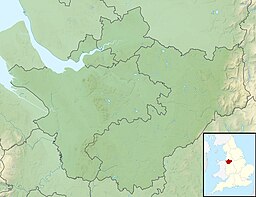Rostherne Mere is a natural lake in Cheshire, England. It is the largest of the Cheshire meres with an area of 48 hectares (120 acres) and a maximum depth of 30 metres (98 ft).[2][3] It lies north of Rostherne village and south of the M56 motorway. Because of its importance for wildlife, the lake, together with neighbouring areas of woodland and pasture, has been declared a national nature reserve, a Ramsar site and a Site of Special Scientific Interest covering 152.9 hectares (378 acres).[4]
| Rostherne Mere | |
|---|---|
 View across the mere | |
| Location | Cheshire |
| Coordinates | 53°21′14″N 2°23′13″W / 53.354°N 2.387°W |
| Basin countries | United Kingdom |
| Surface area | 48 ha (120 acres) |
| Average depth | 30 m (98 ft) |
| Designated | 24 July 1981 |
| Reference no. | 221[1] |
Geography
editThe lake lies on thick sedimentary deposits of glacial origin above marl and salt-beds.[5] It was probably formed by a combination of retreating glaciers creating a kettle hole and subsidence caused by the underlying rock salt dissolving away.[5] The lake is fertile and base-rich with high levels of phosphate, nitrate and ammonia.[5] Nutrient levels have risen as a result of inflow from surrounding farmland and streams and because of the droppings from large numbers of roosting birds.[4]
Wildlife
editLarge numbers of ducks winter on the lake including tufted duck, pochard, goldeneye, teal and wigeon.[3] Roosting birds include up to 10,000 black-headed gulls, 1000 common gulls and 300 cormorants.[3] Breeding birds include great crested grebe, reed warbler and sedge warbler, while lesser spotted woodpecker and little owl occur in the surrounding area.[3]
The reserve has a variety of butterfly species including white-letter hairstreak, purple hairstreak and common blue.[2] There are few invertebrates in the deeper parts of the lake but shallower areas are home to various gastropod molluscs and leeches.[5]
The lake lacks submerged vegetation but has floating beds of yellow water-lily and white water-lily.[5] Around the edge are areas of birch and willow and reedbeds with common reed, lesser reedmace and sweet flag.[4] The woodland consists mainly of oak and has patches of wood sorrel, yellow archangel and early purple orchid at ground level.[4]
Folklore
editAccording to legend, Rostherne Mere is the home of a mermaid, who can sometimes be heard ringing a sunken bell beneath the water.[6]
References
edit- ^ "Rostherne Mere". Ramsar Sites Information Service. Retrieved 25 April 2018.
- ^ a b Natural England. Rostherne Mere NNR. Retrieved 26 April 2012.
- ^ a b c d Guest, Jonathan; Hutcheson, Malcolm (1997). Where to Watch Birds in Cumbria, Lancashire & Cheshire. London: A&C Black. ISBN 0713644796.
- ^ a b c d Natural England. Rostherne Mere: Citation. Retrieved 26 April 2012.
- ^ a b c d e Ratcliffe, Derek A., ed. (1977). A Nature Conservation Review. Vol. 2: site accounts. Cambridge: Cambridge University Press. ISBN 0521214033.
- ^ "BBC - Domesday Reloaded: ROTHERNE CHURCH AND LEGEND". BBC. 1986. Retrieved 24 August 2014.
